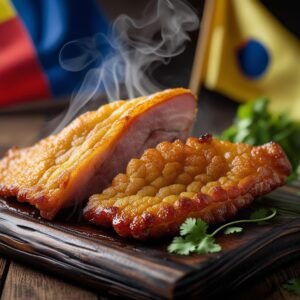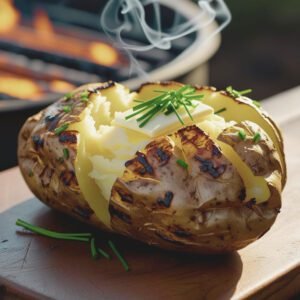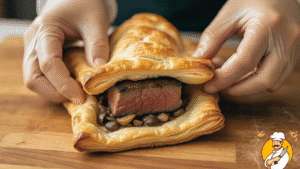There’s something unforgettable about your first bite of karaage. The crisp, golden shell crackles, revealing chicken so juicy inside it practically melts in your mouth. I remember mine clearly—it wasn’t from a trendy restaurant or street stall, but in a quiet Tokyo kitchen, barefoot on cold tile, while my friend’s mother served it fresh from the pan. That single, perfect bite of fried chicken sparked an obsession I still carry today.
Since then, I’ve made karaage countless times—at home and abroad, for friends and family. No matter where I serve it, the reaction is always the same: “This is incredible—what’s in it?”
And that’s the beauty of karaage. It’s honest, flavorful, and comforting—an everyday dish with extraordinary taste. Unlike heavier fried foods, karaage uses a delicate coating and a powerful marinade method, resulting in something that’s light, crisp, and packed with umami.
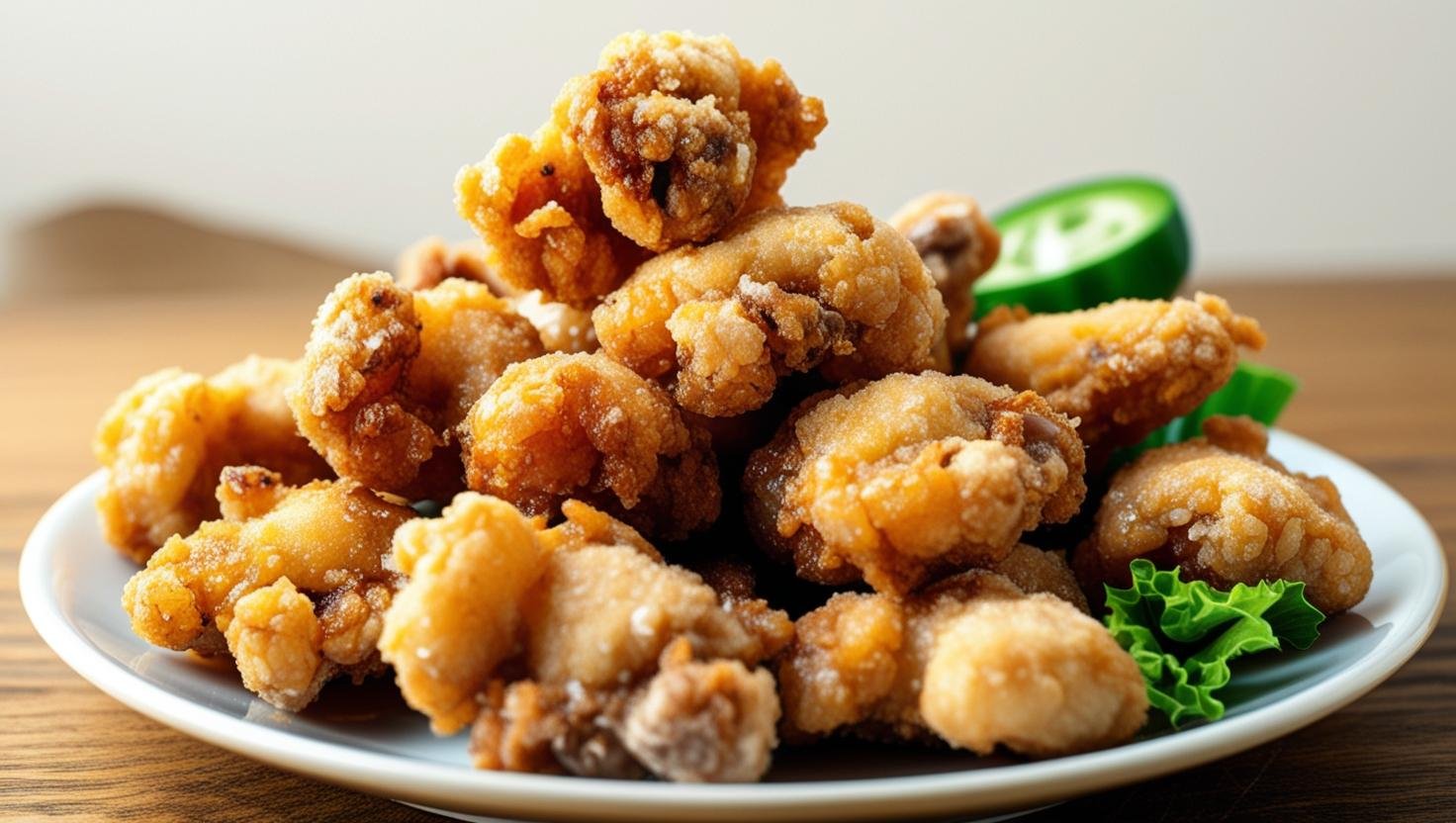
What Is Karaage (唐揚げ)?
Table of Contents
ToggleKaraage (唐揚げ) is Japan’s answer to the perfect fried chicken. But it’s more than just technique—it’s tradition. The process starts with chicken thigh fillets, typically skin-on for extra flavor, marinated in a mix of soy sauce, sake, grated ginger, and sometimes mirin or garlic. This deep marinade gives the chicken its rich, savory base.
Instead of heavy batter, the chicken is lightly coated in cornstarch, potato starch, or a mix with plain flour. It’s then deep-fried in hot oil, often double-fried for that perfect crunchy outside.
🍴 You’ll find karaage in lunch boxes, street food stalls, izakayas (Japanese pubs), and homes across Japan. It’s a popular food and a comforting main dish that brings people together.
🍶 Karaage vs Tatsuta-age: What’s the Difference?
While karaage and tatsuta-age are often used interchangeably, there are subtle differences between these two beloved styles of Japanese fried chicken.
Karaage (唐揚げ) typically uses a marinade of soy sauce, sake, and ginger, followed by a light coating of cornstarch, potato starch, or flour before deep frying. The emphasis is on a crisp, thin crust and a juicy, flavorful interior—often achieved with double frying.
Tatsuta-age (竜田揚げ), on the other hand, always uses potato starch (never flour), resulting in a lighter, even crispier texture. Its marinade leans more toward a sweeter profile, usually combining soy sauce, mirin, and sometimes sugar substitute. You’ll often see it served with a side of grated white radish or a citrusy ponzu sauce.
Both dishes are popular food choices in Japanese home cooking and bento boxes. The choice between them comes down to personal taste—karaage is bolder and more savory, while tatsuta-age offers a delicate crunch with slightly sweeter notes.
💡 Tip: Try both and see which one you (or your children) love more. They’re easy to make with similar ingredients, so you can switch it up based on what’s in your pantry!
🛒 Ingredients You Will Need
Main Ingredients:
- 500g (1 lb) chicken thigh fillets (preferably skin-on)
- 2 tbsp soy sauce 🧂
- 1 tbsp sake 🍶
- 1 tsp grated ginger 🫚
- 1 clove garlic, minced (optional)
- 1 tsp sugar substitute or sugar 🍬 (optional)
- 1 tbsp mirin (optional for added sweetness)
For Coating:
- 2 tbsp cornstarch
- 2 tbsp plain flour (or potato starch for a gluten-free option)
For Frying:
- Enough vegetable oil or sesame oil 🛢️ to fully submerge chicken pieces
Optional Garnish:
- 🥬 Shredded lettuce, cabbage, or parsley
- 🍋 Lemon wedges for freshness
🔪 Step-by-Step Instructions
1️⃣ Cut the Chicken
Slice the chicken thigh fillets into 2-inch cut pieces for even cooking.
💡 Tip: Keep the skin-on for extra crispness and flavor.
2️⃣ Marinate the Chicken
Place chicken in a bowl or ziplock bag. Add:
- Soy sauce
- Sake
- Grated ginger
- Garlic (optional)
- Mirin or sugar substitute (optional)
Mix and massage the marinade into the meat. Refrigerate for at least 30 minutes 🕒 (or overnight for stronger flavor).
💡 Tip: This step is essential—marination adds depth and umami.
3️⃣ Prepare the Coating
In a separate bowl, combine:
- Cornstarch
- Plain flour (or potato starch)
💡 Tip: This combo ensures a perfectly golden brown, crispy texture.
4️⃣ Coat the Chicken
Remove chicken from the marinade and pat-dry with a paper towel. Coat each piece evenly in the flour-starch mix.
💡 Tip: Drying prevents the coating from falling off during frying.
5️⃣ Heat the Oil
Pour vegetable or sesame oil into a deep pan or pot. Heat until the oil temperature reaches 170–180°C (340–355°F) 🌡️.
📏 No thermometer? Dip a wooden chopstick—if bubbles appear quickly, it’s ready.
💡 Tip: Hot oil is key to fry food properly. Cold oil = greasy chicken.
6️⃣ First Fry – Cook the Chicken
Fry the chicken in batches—don’t overcrowd the pan.
🕒 Fry for 3–4 minutes until light golden. Transfer to a wire rack or paper towel to drain.
💡 Tip: Let the oil return to temp between batches for crispier results.
7️⃣ Second Fry – Double Fry for Crunch!
After resting 5–7 minutes, fry again at 190°C (375°F) for 30–60 seconds 🔥.
💡 Tip: Double frying = crunchy outside, juicy chicken inside. Totally worth it.
8️⃣ Drain and Serve
Let the chicken cool slightly on a wire rack or paper towel. Serve hot with shredded veggies, lemon, or a bowl of rice 🍚 and miso soup 🍲.
✅ Extra Tips for Perfect Karaage
🧊 Batch & reheat: Freeze extra and use the oven to reheat later.
🌾 Gluten-free option: Use potato starch + tamari instead of soy sauce.
🌱 Alternative proteins: Try it with fish, tofu, or even scrambled tofu.
🌶️ Flavor twist: Add chili powder, sesame seeds, or scallions to the marinade.

🍽 Final Thoughts
Making karaage at home is easier than you think—and incredibly rewarding. With just a few pantry staples, proper cooking methods, and attention to oil temperature, you’ll get crispy, juicy results that rival any restaurant.
It’s more than just fried chicken—it’s a dish that brings comfort, flavor, and joy. Whether for a cozy dinner, a gathering, or sharing a taste of Japan with someone new, karaage is always a hit.
Let me know if you try it—I’d love to hear how it turns out! 😊
Karaage Chicken (FAQs)
Can I use chicken breast instead of thigh for karaage?
Yes, you can use skinless chicken breast fillets if you prefer a leaner option. However, chicken thigh fillets (especially skin-on) are more traditional and result in juicier, more flavorful karaage.
What oil is best for frying karaage?
Vegetable oil is a common choice, but for a more aromatic flavor, sesame oil or a blend of both works beautifully. Just be sure to maintain the correct oil temperature (170–180°C / 340–355°F).
Why do you double-fry karaage?
Double frying ensures the outside stays crunchy while the inside remains juicy. The first fry cooks the chicken through; the second fry crisps the coating without overcooking the meat.
Can I air fry karaage instead of deep frying?
You can, but it won’t be exactly the same. Air frying can give a crisp texture with less oil, but it may not achieve the same golden brown finish and depth of flavor as traditional deep frying.
How do I store and reheat leftovers?
Store cooled karaage in an airtight container in the fridge for up to 3 days, or freeze for up to 1 month. Reheat in a preheated oven or air fryer at 180°C (350°F) for 5–8 minutes to restore crispness. Avoid microwaving—it can make the coating soggy.
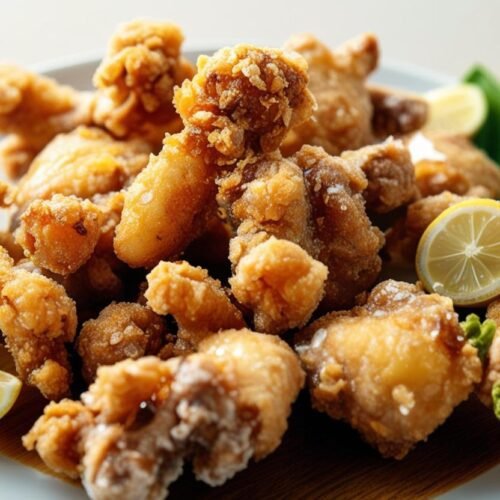
Authentic Japanese Karaage (Fried Chicken)
Equipment
- Sharp kitchen knife
- cutting board
- Mixing Bowls – For marinating and coating
- Measuring spoons
- Ziplock bag or airtight container (for marination)
- Paper towels (for drying and draining)
- Deep frying pan, wok, or pot
- Cooking thermometer (for accurate oil temperature)
- Slotted spoon or tongs (for frying)
- Wire rack or plate with paper towels (for draining)
- Serving plate or platter
Ingredients
- Main Ingredients:
- 500 g 1 lb chicken thigh fillets, skin-on preferred
- 2 tbsp soy sauce
- 1 tbsp sake
- 1 tsp grated ginger
- 1 clove garlic minced (optional)
- 1 tsp sugar or sugar substitute optional
- 1 tbsp mirin optional
- For Coating:
- 2 tbsp cornstarch
- 2 tbsp plain flour or potato starch for gluten-free option
- For Frying:
- Enough vegetable oil or sesame oil to deep-fry
- Optional Garnish:
- Shredded lettuce or cabbage
- Fresh parsley
- Lemon wedges
Instructions
- Cut the Chicken
- Slice chicken into 2-inch bite-sized pieces for even cooking.
- Marinate
- In a bowl or ziplock bag, mix soy sauce, sake, ginger, garlic, sugar, and mirin.
- Add chicken, massage the marinade in, seal, and refrigerate for 30 minutes to overnight.
- Prepare the Coating
- In a clean bowl, combine cornstarch and plain flour.
- Coat the Chicken
- Pat each chicken piece dry with a paper towel.
- Dredge in the flour-starch mixture until fully coated.
- Heat the Oil
- Pour oil into a deep pan.
- Heat to 170–180°C (340–355°F). Use a thermometer or test with a chopstick—bubbles should form rapidly.
- First Fry
- Fry chicken in batches for 3–4 minutes until light golden.
- Drain on a wire rack or paper towel. Let oil reheat between batches.
- Second Fry (Double-Frying Method)
- After 5–7 minutes of resting, fry chicken again at 190°C (375°F) for 30–60 seconds until crispy.
- Drain again on a wire rack.
- Serve
- Plate with shredded cabbage, lemon wedges, and optionally, steamed rice and miso soup.
Video
Notes
Storage & Reheating Tips:
- Refrigerate: Store in an airtight container for up to 3 days.
- Freeze: Lay pieces flat on a tray before transferring to a freezer bag. Keeps for up to 1 month.
- Reheat: Best reheated in the oven or air fryer at 180°C (350°F) for 5–8 minutes. Avoid microwaving to keep the coating crisp.

